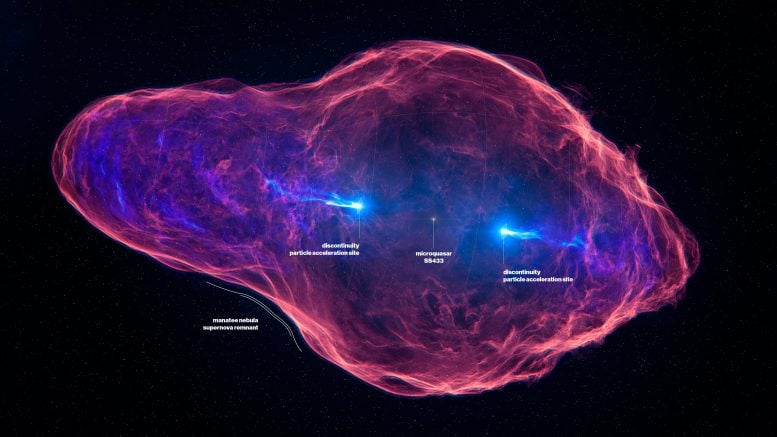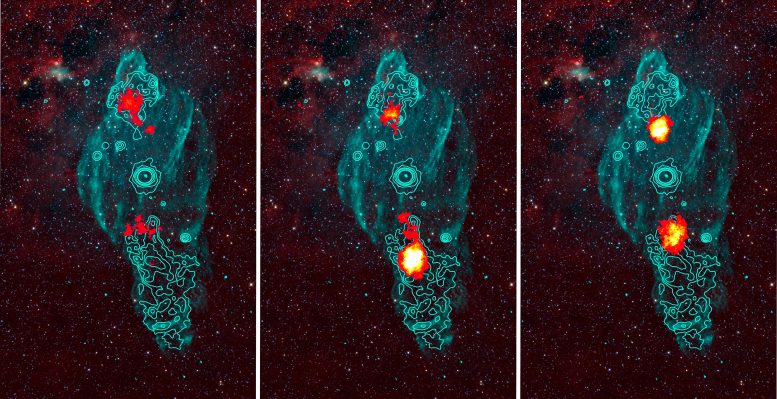
Recent studies of SS 433 have unveiled the mechanisms behind its gamma-ray emissions, revealing how particles are accelerated within its jets. This discovery challenges existing theories and provides a closer look at the processes driving relativistic jets, crucial for understanding cosmic phenomena. Credit: SciTechDaily.com
How Gamma Rays Track the Velocity of the Galactic Microquasar SS 433’s Jets and Uncover Highly Efficient Particle Acceleration.
The microquasar SS 433 stands out as one of the most intriguing objects within our Milky Way.A pair of oppositely directed beams of plasma (“jets”) spirals away perpendicularly from the binary systems disk’s surface at just over a quarter of the speed of light.The H.E.S.S. observatory in Namibia has now succeeded in detecting very high energy gamma rays from the jets of SS 433, and identifying the exact location within the jets of one of the galaxy’s most effective particle accelerators.Through comparison of gamma-ray images at different energies, the H.E.S.S. collaboration was able to estimate the speed of the jet far from its launch site for the first time, constraining the mechanism that is accelerating the particles so efficiently.
SS 433 stands out as one of the most intriguing objects within our Milky Way. At its core, a black hole draws material from a closely orbiting companion star, creating a hot accretion disk. Notably, a pair of oppositely directed beams of plasma (“jets”) spirals away perpendicularly from the disk’s surface at just over a quarter of the speed of light. The H.E.S.S. observatory in Namibia has now succeeded in detecting very high energy gamma rays from the jets of SS 433, and identifying the exact location within the jets of one of the galaxy’s most effective particle accelerators. Through comparison of gamma-ray images at different energies, scientists from the Max-Planck-Institut für Kernphysik in Heidelberg and the H.E.S.S. collaboration revealed the motion and dynamics of a relativistic jet in our own galaxy, offering valuable insights into these extraordinary astrophysical phenomena. The results are published in the current issue of the journal Science.
Artist’s impression video visualization of the SS 433 system and summary of the main results of the paper. Credit: Science Communication Lab for MPIK/H.E.S.S.
Arthur C. Clarke’s Unique Wonder: SS 433
The science fiction author Arthur C. Clarke selected his own seven wonders of the world in a BBC television series in 1997. The only astronomical object he included was SS 433. It had attracted attention already in the late 1970s due to its X-ray emission and was later discovered to be at the center of a gas nebula that is dubbed the manatee nebula due to its unique shape resembling these aquatic mammals.
The Mystery of SS 433’s Jets
SS 433 is a binary star system in which a black hole, with a mass approximately ten times that of the Sun, and a star, with a similar mass but occupying a much larger volume, orbit each other with a period of 13 days. The intense gravitational field of the black hole rips material from the surface of the star, which accumulates in a hot gas disk that feeds the black hole. As matter falls in toward the black hole, two collimated jets of charged particles (plasma) are launched, perpendicular to the plane of the disk, at a quarter of the speed of light (see figure 1).

Figure 1. Artist’s impression of the SS 433 system, depicting the large-scale jets (blue) and the surrounding Manatee Nebula (red). The jets are initially observable only for a short distance from the microquasar after launch — too small to be visible in this picture. The jets then travel undetected for a distance of approximately 75 light-years (25 parsecs) before undergoing a transformation, abruptly reappearing as bright sources of non-thermal emission (X-ray and gamma-ray). Particles are efficiently accelerated at this location, likely indicating the presence of a strong shock: a discontinuity in the medium capable of accelerating particles. Credit: Science Communication Lab for MPIK/H.E.S.S.
The jets of SS433 can be detected in the radio to x-ray ranges out to a distance of less than one light year either side of the central binary star, before they become too dim to be seen. Yet surprisingly, at around 75 light-years distance from their launch site, the jets are seen to abruptly reappear as bright X-ray sources. The reasons for this reappearance have long been poorly understood.
Similar relativistic jets are also observed emanating from the centers of active galaxies (for example quasars), though these jets are much larger in size than the galactic jets of SS 433. Due to this analogy, objects like SS 433 are classified as microquasars.
Groundbreaking Gamma Ray Detection
Until recently, no gamma ray emission has ever been detected from a microquasar. But this changed in 2018, when the High Altitude Water Cherenkov Gamma-ray Observatory (HAWC), for the first time, succeeded in detecting very-high-energy gamma rays from the jets of SS 433. This means that somewhere in the jets particles are accelerated to extreme energies. Despite decades of research, it is still unclear how or where particles are accelerated within astrophysical jets.

Figure 2. Composite images of SS 433 showing three different gamma-ray energy ranges. In green, radio observations display the Manatee Nebula with the microquasar visible as a bright dot near the center of the image. Solid lines show the outline of the x-ray emission from the central regions and the large scale jets after their reappearance. Red colors represent the gamma-ray emission detected by H.E.S.S. at a) low (0.8-2.5 TeV, left), b) intermediate (2.5-10 TeV, middle) and c) high (>10 TeV, right) energies. The position of the gamma-ray emission shifts further from the central launching site as the energy decreases. Credit: Background: NRAO/AUI/NSF, K. Golap, M. Goss; NASA’s Wide Field Survey Ex-plorer (WISE); X-Ray (green contours): ROSAT/M. Brinkmann; TeV (red colors): H.E.S.S. collaboration.
The study of gamma-ray emission from microquasars provides one crucial advantage: while the relevant region of the jets in SS 433 is more than 50 times smaller than those of the closest active galaxy (Centaurus A), SS 433 is located inside the Milky Way a thousand times closer to Earth. As a consequence, the apparent size of the relevant region in the jets of SS 433 in the sky is much larger and thus its properties are easier to study with the current generation of gamma-ray telescopes.
Pinpointing Gamma Ray Emission
Prompted by the HAWC detection, the H.E.S.S. Observatory initiated an observation campaign of the SS 433 system. This campaign resulted in around 200 hours of data and a clear detection of gamma-ray emission from the jets of SS 433. The superior angular resolution of the H.E.S.S. telescopes in comparison to earlier measurements allowed the researchers to pinpoint the origin of the gamma-ray emission within the jets for the first time, yielding intriguing results:
While no gamma-ray emission is detected from the central binary region, emission abruptly appears in the outer jets at a distance of about 75 light-years either side of the binary star, in accordance to previous X-ray observations.
However, what surprised the astronomers most, was a shift in the position of the gamma-ray emission when viewed at different energies.
The gamma-ray photons with the highest energies of more than 10 teraelectron-volts, are only detected at the point where the jets abruptly reappear (see figure 2c). By contrast, the regions emitting gamma rays with lower energies appear further along each jet (see figure 2).

The H.E.S.S. observatory, located in the Khomas Highlands of Namibia at an altitude of 1835m below the southern sky. Credit: Sabine Gloaguen
“This is the first-ever observation of energy-dependent morphology in the gamma-ray emission of an astrophysical jet,” remarks Laura Olivera-Nieto, from the Max-Planck-Institut für Kernphysik in Heidelberg, who was leading the H.E.S.S. study of SS 433 as part of her doctoral thesis. “We were initially puzzled by these findings. The concentration of such high energy photons at the sites of the X-ray jets’ reappearance means efficient particle acceleration must be taking place there, which was not expected.”
The Science Behind the Phenomenon
The scientists did a simulation of the observed energy dependence of the gammy-ray emission and were able to achieve the first-ever estimate of the velocity of the outer jets. The difference between this velocity and the one with which the jets are launched suggests that the mechanism that accelerated the particles further out is a strong shock- a sharp transition in the properties of the medium. The presence of a shock would then also provide a natural explanation for the x-ray reappearance of the jets, as accelerated electrons also produce x-ray radiation.
“When these fast particles then collide with a light particle (photon), they transfer part of their energy – which is how they produce the high-energy gamma photons observed with H.E.S.S. This process is called the inverse Compton effect,” explains Brian Reville, group leader of the Astrophysical Plasma Theory group at the Max Planck Institute for Nuclear Physics in Heidelberg.
Unveiling Particle Acceleration in SS 433
“There has been a great deal of speculation about the occurrence of particle acceleration in this unique system — not anymore: the H.E.S.S. result really pins down the site of acceleration, the nature of the accelerated particles, and allows us to probe the motion of the large-scale jets launched by the black hole,” points-out Jim Hinton, Director of the Max Planck Institute for Nuclear Physics in Heidelberg and Head of the Non-thermal Astrophysics Department.
“Just a few years ago, it was unthinkable that ground-based gamma-ray measurements could provide information about the internal dynamics of such a system” adds coauthor Michelle Tsirou, a postdoctoral researcher at DESY Zeuthen.
However, nothing is known about the origin of the shocks at the sites where the jet reappears. “We still don’t have a model that can uniformly explain all the properties of the jet, as no model has yet predicted this feature” explains Olivera-Nieto. She wants to devote herself to this task next — a worthwhile goal, as the relative proximity of SS 433 to Earth offers a unique opportunity to study the occurrence of particle acceleration in relativistic jets. It is hoped that the results can be transferred to the thousand-times larger jets of active galaxies and quasars, which would help solve the many puzzles concerning the origin of the most energetic cosmic rays.
Reference: “Acceleration and transport of relativistic electrons in the jets of the microquasar SS 433” by H.E.S.S. Collaboration*†, F. Aharonian, F. Ait Benkhali, J. Aschersleben, H. Ashkar, M. Backes, V. Barbosa Martins, R. Batzofin, Y. Becherini, D. Berge, K. Bernlöhr, B. Bi, M. Böttcher, C. Boisson, J. Bolmont, M. de Bony de Lavergne, J. Borowska, M. Bouyahiaoui, M. Breuhaus, R. Brose, A. M. Brown, F. Brun, B. Bruno, T. Bulik, C. Burger-Scheidlin, S. Caroff, S. Casanova, R. Cecil, J. Celic, M. Cerruti, T. Chand, S. Chandra, A. Chen, J. Chibueze, O. Chibueze, G. Cotter, S. Dai, J. Damascene Mbarubucyeye, A. Djannati-Ataï, A. Dmytriiev, V. Doroshenko, K. Egberts, S. Einecke, J.-P. Ernenwein, M. Filipovic, G. Fontaine, M. Füßling, S. Funk, S. Gabici, S. Ghafourizadeh, G. Giavitto, D. Glawion, J.-F. Glicenstein, G. Grolleron, L. Haerer, J. A. Hinton, W. Hofmann, T. L. Holch, M. Holler, D. Horns, M. Jamrozy, F. Jankowsky, A. Jardin-Blicq, V. Joshi, I. Jung-Richardt, E. Kasai, K. Katarzyński, R. Khatoon, B. Khélifi, S. Klepser, W. Kluźniak, Nu. Komin, K. Kosack, D. Kostunin, A. Kundu, R. G. Lang, S. Le Stum, F. Leitl, A. Lemière, J.-P. Lenain, F. Leuschner, T. Lohse, A. Luashvili, I. Lypova, J. Mackey, D. Malyshev, D. Malyshev, V. Marandon, P. Marchegiani, A. Marcowith, G. Martí-Devesa, R. Marx, A. Mehta, A. Mitchell, R. Moderski, L. Mohrmann, A. Montanari, E. Moulin, T. Murach, K. Nakashima, M. de Naurois, J. Niemiec, A. Priyana Noel, S. Ohm, L. Olivera-Nieto, E. de Ona Wilhelmi, M. Ostrowski, S. Panny, M. Panter, R. D. Parsons, G. Peron, D. A. Prokhorov, G. Pühlhofer, M. Punch, A. Quirrenbach, P. Reichherzer, A. Reimer, O. Reimer, H. Ren, M. Renaud, B. Reville, F. Rieger, G. Rowell, B. Rudak, H. Rueda Ricarte, E. Ruiz-Velasco, V. Sahakian, H. Salzmann, A. Santangelo, M. Sasaki, J. Schäfer, F. Schüssler, U. Schwanke, J. N. S. Shapopi, H. Sol, A. Specovius, S. Spencer, L. Stawarz, R. Steenkamp, S. Steinmassl, C. Steppa, K. Streil, I. Sushch, H. Suzuki, T. Takahashi, T. Tanaka, A. M. Taylor, R. Terrier, M. Tsirou, N. Tsuji, T. Unbehaun, C. van Eldik, M. Vecchi, J. Veh, C. Venter, J. Vink, T. Wach, S. J. Wagner, F. Werner, R. White, A. Wierzcholska, Yu Wun Wong, M. Zacharias, D. Zargaryan, A. A. Zdziarski, A. Zech, S. Zouari and N. Żywucka, 25 January 2024, Science.
DOI: 10.1126/science.adi2048
>>> Read full article>>>
Copyright for syndicated content belongs to the linked Source : SciTechDaily – https://scitechdaily.com/breaking-cosmic-speed-limits-powerful-astrophysical-jet-challenges-existing-theories/






























